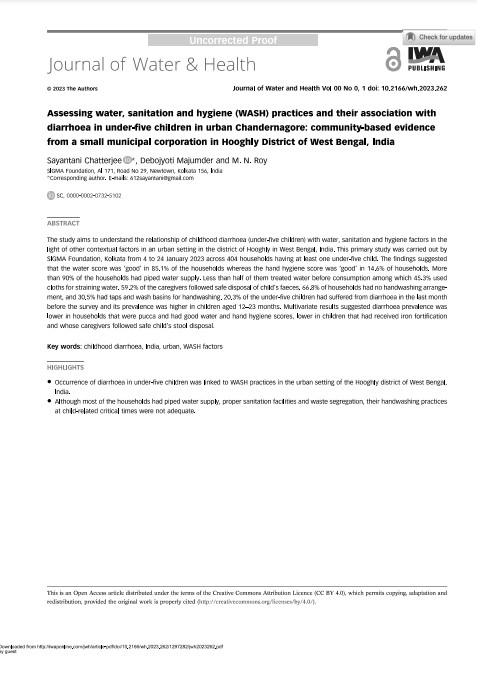Assessing water, sanitation and hygiene (WASH) practices and their association with diarrhoea in under-five children in urban Chandernagore: community-based evidence from a small municipal corporation in Hooghly District of West Bengal, India
 |
article Jan 2023 ; 20 pages
Ed. IWA - London
Téléchargeable sous format: PdF
Téléchargeable chez l'éditeur
Abstract:
The study aims to understand the relationship of childhood diarrhoea (under-five children) with water, sanitation and hygiene factors in the light of other contextual factors in an urban setting in the district of Hooghly in West Bengal, India. This primary study was carried out by SIGMA Foundation, Kolkata from 4 to 24 January 2023 across 404 households having at least one under-five child. The findings suggested that the water score was ‘good’ in 85.1% of the households whereas the hand hygiene score was ‘good’ in 14.6% of households. More than 90% of the households had piped water supply. Less than half of them treated water before consumption among which 45.3% used cloths for straining water. 59.2% of the caregivers followed safe disposal of child's faeces. 66.8% of households had no handwashing arrangement, and 30.5% had taps and wash basins for handwashing. 20.3% of the under-five children had suffered from diarrhoea in the last month before the survey and its prevalence was higher in children aged 12–23 months. Multivariate results suggested diarrhoea prevalence was lower in households that were pucca and had good water and hand hygiene scores, lower in children that had received iron fortification and whose caregivers followed safe child's stool disposal.
Mots clefs: |
Pays concerné: |
Editeur/Diffuseur: |
|
IWA
-
International Water Association - London - Royaume Uni |
En cas de lien brisé, nous le mentionner à communication@pseau.org